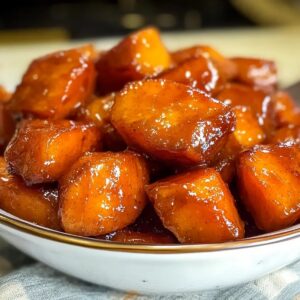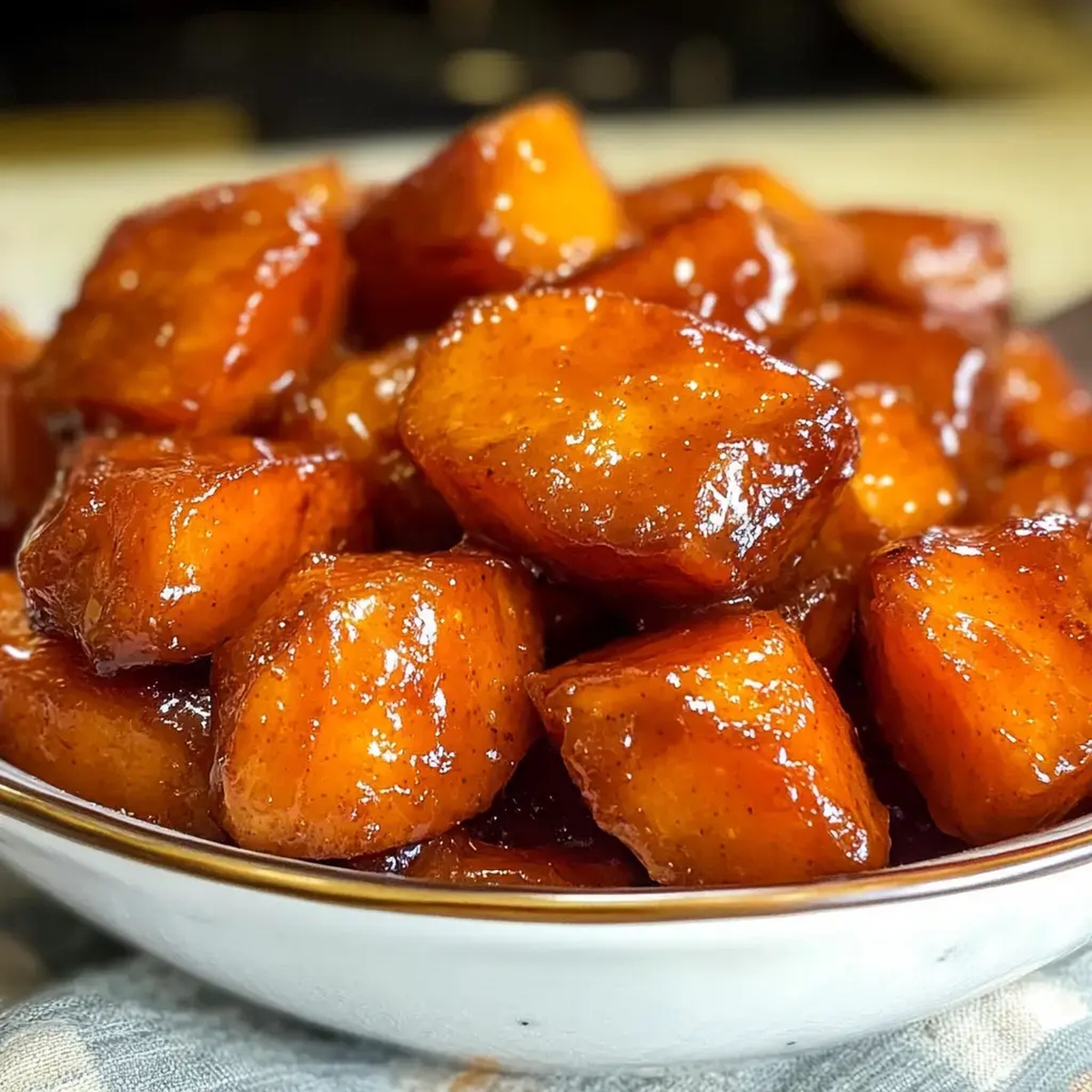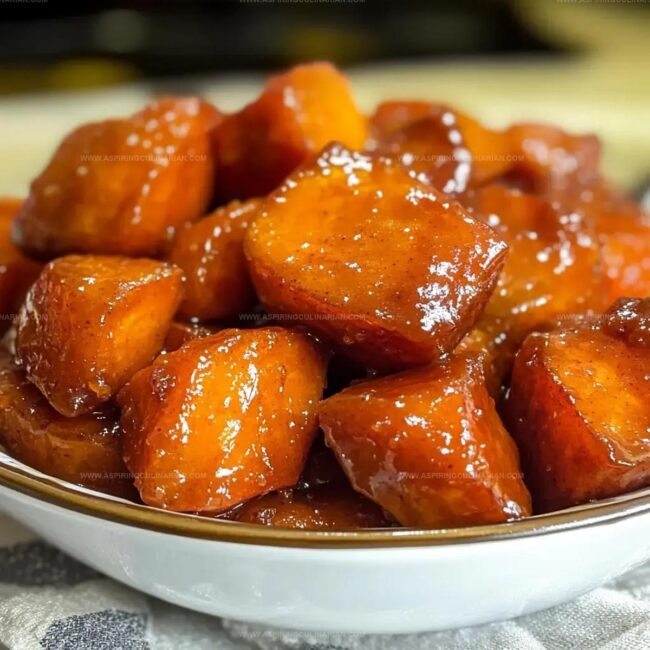The Best Southern Candied Yams Recipe for Cozy Family Dinners
Southern candied yams dance with sweet, caramelized perfection on your holiday table.
These creamy, golden roots capture generations of Southern comfort.
Butter and brown sugar melt into a luscious glaze that coats each tender slice.
Grandmothers across the South have passed down this treasured recipe through decades of family gatherings.
Warm spices like cinnamon and nutmeg add depth to the classic side dish.
The result is a mouthwatering blend of sweetness and nostalgia that beckons everyone to the table.
You’ll savor every decadent bite of this soul-warming Southern tradition.
Soul Food Classic: Reasons It’s Always Loved
Everything for a Great Soul Food Classic
Yams:Sugars and Sweeteners:Liquid and Fat Components:Seasoning:Stepwise Guide to Making Soul Food Classic
Step 1: Prepare Yams
Thoroughly clean the yams under cool running water.
Use a vegetable peeler to remove the skin completely.
Slice the yams into uniform half-inch thick rounds, ensuring each piece is roughly the same size for even cooking.
Step 2: Create Flavor Base
Gather your ingredients:Combine all ingredients in a medium-sized pot positioned over medium-high heat.
Gently stir the mixture to start melding the flavors together.
Step 3: Coat And Distribute
Carefully stir the yam slices, ensuring each round gets completely covered in the rich sugar-butter mixture.
Make sure every piece is evenly coated for maximum flavor absorption.
Step 4: Initial Cooking
Bring the mixture to a rolling boil, then reduce heat.
Cover the pot with a tight-fitting lid and allow the yams to simmer for approximately 50 minutes.
The goal is to achieve a tender texture where a fork can easily pierce the yam slices.
Step 5: Reduce And Thicken
Remove the lid and increase the heat to medium.
Continue cooking, stirring occasionally, for about 10 minutes.
Watch as the liquid transforms into a glossy, thick syrup that clings beautifully to the yam slices.
Step 6: Serve And Maintain
Transfer the candied yams to a warm serving dish.
If not serving immediately, place the dish in a low-temperature oven to keep the yams warm and maintain their delectable glaze until ready to serve.
Pro Tips for Soul Food Classic Flavors
Soul Food Classic – Recipe Variations
Serving a Soul Food Classic with Heart
Storing Soul Food Classic the Right Way
FAQs
While delicious, candied yams are more of a treat due to high sugar content. They contain vitamins from yams but are not considered a low-calorie option.
Yes, sweet potatoes work perfectly and can be substituted directly in this recipe. They have similar texture and sweetness levels.
The yams are done when they’re tender and can be easily pierced with a fork. They should be soft but not mushy or falling apart.
Brown sugar is recommended as it provides deeper flavor and helps create a richer, more caramelized syrup compared to white sugar.
Print
Southern Candied Yams Recipe
- Total Time: 1 hour 15 minutes
- Yield: 8 1x
Description
Sweet, soul-satisfying Southern Candied Yams bring nostalgic comfort straight from grandmother’s kitchen, blending rich brown sugar, warm spices, and buttery goodness. Creamy golden yams caramelize into a divine side dish that connects generations with each delectable, memorable bite.
Ingredients
Main Ingredients:
- 2 lbs (907 grams) sweet potatoes
- 1 stick (113 grams) butter
Sugars and Sweeteners:
- 3/4 cup (150 grams) dark or light brown sugar
- 1 cup (200 grams) white sugar
Spices and Flavor Enhancers:
- 2 teaspoons cinnamon
- 1 teaspoon nutmeg
- 1/4 teaspoon ginger
- 1/4 teaspoon salt
- 2 tablespoons vanilla extract
- 4 tablespoons frozen orange juice concentrate, thawed
Instructions
- Thoroughly cleanse sweet potatoes, removing any blemishes, then carefully slice into uniform half-inch circular discs.
- Transfer all prepared components into a medium-sized cooking vessel, positioning over moderate to high thermal intensity.
- Gently maneuver sweet potato rounds, ensuring complete coverage with caramelized sugar and butter emulsion.
- Elevate culinary mixture to boiling point, then reduce thermal energy, covering pot and allowing gentle simmering for approximately 50 minutes until vegetable segments reach optimal tenderness.
- Remove protective lid, incrementally increase thermal regulation to moderate setting.
- Continue active cooking process, periodically stirring liquid components, enabling syrup to condense and transform into rich, viscous consistency through 10-minute reduction period.
- Maintain prepared dish at consistent warmth within oven compartment until meal presentation moment arrives.
Notes
- Choose firm, unblemished yams for the best texture and flavor.
- Use a sharp knife to slice yams evenly, ensuring consistent cooking and attractive presentation.
- Watch closely during the final boiling stage to prevent burning while developing a rich, glossy syrup.
- Reduce sugar for a lighter version or use alternative sweeteners like honey or maple syrup for a different flavor profile.
- Prep Time: 15 minutes
- Cook Time: 1 hour
- Category: Dinner, Side Dish, Snacks
- Method: Simmering
- Cuisine: Southern
Nutrition
- Serving Size: 8
- Calories: 346
- Sugar: 32 g
- Sodium: 85 mg
- Fat: 11 g
- Saturated Fat: 7 g
- Unsaturated Fat: 4 g
- Trans Fat: 0 g
- Carbohydrates: 57 g
- Fiber: 4 g
- Protein: 2 g
- Cholesterol: 30 mg





Nathaniel Brooks
Founder & Recipe Developer
Expertise
Farm-to-table cuisine, Seasonal recipe development, Culinary storytelling
Education
Ivy Tech Community College – Indianapolis, IN
Culinary Arts / Hospitality Administration & Events
Focused on hands-on training in classical and modern culinary techniques.
Nathaniel’s story starts in the foothills of the Appalachian Mountains, where farm stands, backyard gardens, and old family recipes shaped his love for real food. After graduating from Ivy Tech Community College in Indianapolis, he spent years working in farm-to-table kitchens, learning how to turn local, seasonal ingredients into something memorable.
Today, Nathaniel pours that same spirit into every single recipe on Aspiring Culinarian – recipes that feel real, comforting, and connected to the land. When he’s not in the kitchen, you’ll find him foraging wild herbs, chasing sunsets with his camera, or writing about the flavors that shaped his roots.